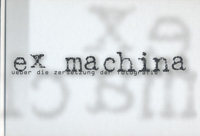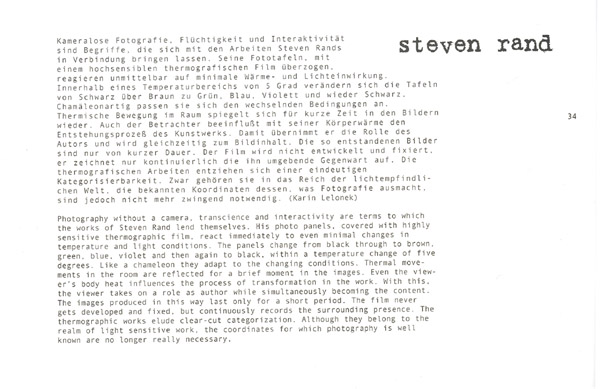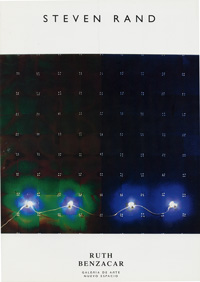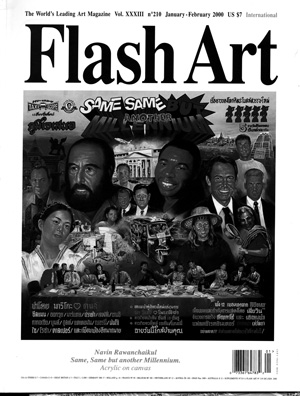Steven Rand
Resume,
Past Catalogs and Reviews
Selected Activities, Group shows,
one-person shows and misc. other
2014:
Executive Director apexart 1994-presen
scheduled apexart int'l exhibitions Phnom Penh, Cambodia; Rumallah, Palestine
2013:
t
Commission, Edit and Publish “Life Between Borders” The Nomadic Life of Curators and Artists
apexart international exhibitions in Kampala,Uganda; Marfa, Texas; Lima, Peru
2012:
apexart international exhibitions in Lima, Peru; Mexico City, Mexico; Memphis, Tenn.;Johannesburg, South Africa
Concentration on apexart programming and development
2011:
apexart international exhibitions in Bangkok, Thailand; Amman, Jordan
Concentration on apexart programming and development
2010:
apexart international exhibitions in
Commission, Edit and Publish “Playing By The Rules” Alternative Thinking/Alternative Spaces
Finished work on Glasshouse Residence Project-pursuing commissions
2009:
continue work on Glasshouse Residence Project
2008:
Organized “Nessie Does New York” *
Produced and Edited “Cautionary Tales-Critical Curating” a collection of essays*
2007:
Glasshouse Residence Project
tribecatrib article
Produced and Edited “On Cultural Influence” a collection of essays*
Organized the “Self Promotion” video project*
Organized “The Most Curatorial Biennial of the Universe” *
Organized “Thanks, Returning the Favor”*
Developed new “Outgoing Resident” Program*
Currently not producing “gallery objects"
tribecatrib
article
2006
conFLUXaction Gallerie Shüppenhauer Cologne,
Germany
"Pablo and Friends "short videos Elizabeth Foundation NYC
"Our
House is a House That Moves"
Living Art Museum Reykjavik,Iceland
2005
Erweiterung Europäisches Patentamt - (European Patent Office)
2004
is a House That Moves
Gallery
Skuc in Ljubljana
lectures Queens College, School of Visual Arts, Parsons, LMCC: NYC,
ARCO-Madrid
2003
Gallerie Shueppenhauer Cologne,
Germany
"Our House is a House That Moves"- Pavel House Laafeld,
Austria
Cynical Culture (curated) Gallerie Shüppenhauer
Cologne, Germany
"Ready-made Color" Centre
d'Art Passerelle Brest, France
Markers Project- Wandering Library at the Jewish Museum in cooperation with
the Biennale Venice Italy
ARCO-Madrid, Spain
2002
ddm warehouse Gallery (one person show) Shanghai, China
"Ready-made Color" Galerie Corinne Caminade Paris, France
Gallerie Shueppenhauer Cologne, Germany
2001
“Ex Machina” NGBK Berlin, Germany
Gallerie Shueppenhauer Cologne, Germany
ARCO-Madrid, Spain
Art/Sante Fe Santa Fe, New Mexico
“Domestica” Biblioteca Luis Angel Arango Bogata, Columbia
White Columns New York, NY
Markers - Project- Art Banners in cooperation with the Biennale Venice Italy Http://www.markersart.com
2000
Mark Pasek Gallery- New York City one person show
Pusan Biennial-PICAF Pusan, Korea
Construction in Process Lodz, Poland
FIAC-Paris
Arco-Madrid
Art Brussels-Belgium
lectures: Rhode Island School of Design, Corcoran Museum, Rutgers University,
Quarini Stampalia Venice, Italy
1999
Galerie Hafemann Wiesbaden, Germany
Ruth Benzacar Gallery Buenos Aires, Argentina one person show
Wschodnia Gallery Lodz ,Poland one person show
Gallerie Shueppenhauer Cologne, Germany two person show
BWA Gallery Wroclaw, Poland (catalog) one person show
Arsenal Galerie Bialystok, Poland (catalog) one person show
White Columns- New York City
Art on the Waterfront- Jersey City, NJ
Smack Mellon Gallery Brooklyn, NY
lecture: Univ. of Texas at Austin
1998
The Fields Sculpture Park Omi, NY- multi year installation
Drawing Society panelist New York State Armory Arts Education 2000 panelist
Rutgers University
1997
Grayson Gallery Woodstock, Vt
Art/Omi Omi, NY-guest lecturer
White Columns- New York City
Marisa Del Ray Gallery - New York City 1996
New Museum New York, New York
White Columns New York, New York "Benefit Auction"
1995
New Museum New York, New York "Human/Nature"
White Columns New York, New York "Benefit Auction"
Curated "All Dressed Up" show at Apex Art (catalog essay)
1994
Apex Art, New York, New York, "Summershow”
The 2nd Fukisankei Biennale, The Hakone Open-Air Museum, Tokyo, Japan
Kouros Sculpture Park, Ridgefield, Connecticut
1993
Kouros Sculpture Park, Ridgefield, Connecticut
1992
The Fukisankei Biennale, Maquette Competition, The Hakone Open- Air Museum,
Tokyo, Japan
1990
Graham Modern, New York, New York, "Integral Tables”
Group SculptureShow Crozier Fine Arts, New York, New York,"Movers
and Makers”
1986
Everson Museum, Syracuse, New York, "Biennial”
1985
University of Arizona Museum of Art, Tucson, Arizona, "Invitational
Alumni Show”
Phoenix Art Museum, Phoenix, Arizona, "Masks for Modern
Living”
Plains Art Museum, Moorhead, Minnesota, "Annual”
1984
Tucson Museum of Art, Tucson, Arizona, "Biennial” Phoenix
Art Museum, Phoenix, Arizona-large work by invitation
Arizona Commission on the Arts- "Bicultural Delegate”
1983
Plains Art Museum, Moorhead, Minnesota-with catalogue (one person)
Alexandria Museum, Alexandria, Louisiana, "Competition”
Coos Art Museum, Coos Bay, Oregon
Carson Sapiro Gallery, Denver, Colorado, "Two-Person Show”
1982
Scottsdale Center for the Arts, Scottsdale, Arizona
John Berggruen Gallery, San Francisco, California
Plains Art Museum, Moorhead, Minnesota, "23rd Midwestern Invitational”
John Berggruen Gallery, San Francisco, California
1981
Montalvo Center for the Arts, Saratoga, California
Oklahoma Arts Center Zaner Gallery, Rochester, New York, "Small Works
National”
Laguna Gloria Art Museum, Austin, Texas, "National”
Plains Art Museum, Moorhead, Minnesota, "22nd Midwestern Invitational”
A.R.T./Beasley Gallery, San Diego, California, "Two-Person
Show”
1980
Marilyn Butler Gallery, Scottsdale, Arizona, "Two-Person Show”
Yuma Art Center, Yuma, Arizona,
"14 Southwestern Invitational” Tucson Museum of Art, Tucson, Arizona,
"Arizona Biennial”
1979
Tucson Museum of Art, Tucson, Arizona, "Invitational”
Scottsdale Center for the Arts, Scottsdale, Arizona, "Welsh Memorial
Competition”



Translation from Steven Rand exhibition 1999 Ruth Benzacar Gallery Buenos Aires, Argentina

In Steven Rand's recent work
the post-war, consumerist leitmotifs of adaptability and universality
emerge as key issues. The viewer, faced with familiar but recontextualized
materials, is compelled to explore a shifting set of personal experiences
and cultural associations. a With the Formica pieces, one first sees
what might be a pixelated image or an abstract field of luminosity.
As the surface is more closely scanned it serves as the catalyst to
inspire a personal, perhaps romantic, memory of the past. This material
has found its way into innumerable shared and private spaces such as
kitchens, bathrooms and offices (at least in North America). The work
takes on a level of relatability that initially might seem to render
it invisible.
Yet Rand relies on the viewer's willingness to enter into dialogue with the
image as a whole (as in the unified pictorial field of a painting) as well
as with each specific sample (which triggers the particular recollections and
nostalgic references). The wide variety of "designs" offered by Formica change
each year as focus-group testing reflects and chronicles the next year's choices,
offering a cross-section of the changing tastes of the middle class in the
United States. The thermographic works, on the other hand, deal more with the
here and now as they constantly shift their color according to environmental
changes. In the morning the panels come to life and as the space heats up,
they change from black to brown then green, blue, violet and back to black
in a five-degree temperature range. The panels are always in tune with their
surroundings, reacting to the convection of warm air rising. In some works
Rand utilizes simple electric light fixtures with mirror-topped bulbs to playfully
comment on the illumination of the art object as well as to provide a heat
source that artificially enhances the subtly changing air currents in the room.
When the viewer encounters both sets of works within the gallery, a curious
split between past and present becomes noticeable, though perhaps not consciously
at first. While familiar counter tops or shelves in one's childhood home might
be conjured up in front of the Formica pieces, the thermographic panels compel
a recognition of the atmospheric conditions of the ever-changing present. Two
separate moments of recognition thus occur: one speaking to deep-seated memories
and the other involving a gradual awareness of the immediate surroundings.
The work and the audience enter into a dialogue in which one must adapt to
the other. Rather than asking the viewer to back up and contemplate the objects
from a remove, Rand encourages close observation and a degree of intimacy.
What is shared by both bodies of work is a heightening of the split between
the universal and the individualized perceptual experience. If the generic,
ubiquitous quality of the Formica materials makes reference to a collective
sensibility, the close examination of each separate sample tile personalizes
it. Likewise, the recognition of one's own direct impact on the color of the
thermographic strips is an idiosyncratic, isolated event taking place within
the parameters of a natural, commonly shared phenomenon. The tension that arises
with this encounter is not unlike the choices facing everyone who participates
in today's consumer culture. A gulf continues to widen between what people
know they want and what the corporate world would like them to think they want.
The trick is to strike a balance that simultaneously acknowledges the power
of the macrocosmic and maintains the integrity of the microcosmic. Rand produces
work that sheds light on our increasingly homogenous society while nurturing
the possibility of a unique experience.
©1999 Gregory Williams


Kolner Stadt-Anzeiger Saturday/Sunday, June 5/6, 1999
Painting without Painting 1 Beautiful Illusions: Steven Rand and Gunther Selicher at Schuppenhauer By Amine Haase
It's all about illusion--ever
since art and nature have existed as two possibilities of reality.
Illusion pokes doubt at reality. We know this from the weasel in the
middle of the trickling stream: a man, or even better, a poet, touches
it...it's made of plaster. [difficult to translate; part of a German
fable that rhymes] Artists nurture such doubts, disarmingly humorous
or deeply serious. Barnett Newman posed the question, "Who's afraid
of red, blue and yellow," and a humorless museum visitor slashed his
red-blue-yellow stripe painting in Amsterdam--perhaps because he was
indeed afraid of the pure colors. Gerhard Richter exhibits the house
painter's palette as a painting atlas, Blinky Palermo created pictorial
effects with the help of lengths of fabric. There are many examples
of the "continuation of painting with other materials." These "other
materials" constantly have their point of departure in the brain, not
in the hand, which carries out the gesture. It has to do with reflecting
on painting, not with its emotional and physical fulfillment. This
illusion of a painting without painting is currently being exemplarily
presented at Galerie Schuppenhauer.
The American Steven Rand and the Austrian Gunther Selicher are showing "visually
experimental arrangements" that "seem to be traditional painting" but are something
completely different. As such they draw our attention not to "the fundamental
principles of painting, but rather to its perception." So says the gallerist
Christel Schuppenhauer about her committed and daring juxtaposition. Next to
the works by Rand and Selicher she has hung a picture by Max Cole, providing
a possible comparison with a conventional painterly conception of minimalist
character. Altered heat In Steven Rand's case, for example, the medium of painterly
illusion is the alteration of the "picture support" through heat. This "support" consists
of liquid-crystal sheets, which are joined together into a wall-embracing "picture," and
the shifting heat is enhanced by lamps. Changes to the surface color can result
from touching the sheets as well as temperature fluctuations in the room. Rand
has also composed "pictures" out of color-pattern tiles, which are in fact
veneer samples. The material with which Steven Rand attains a painterly effect
is a great distance from the conventions valid for centuries.
Gunther Selicher still achieves his pictorial illusion with pure pigments--red,
blue and green. "Who's afraid...?" Not yellow, rather green is the third "primary
color," because it is no longer that of painting but of photography and color
television. Selicher fills neatly separated, double-Plexiglas sheets with the
three pigments so that perfect color stripes result--and one can actually almost
be scared in front of such perfect "pictures." They often have--in a further
media-related allusion--typical screen formats, elevated wide-screen, so to
speak. Quite programmatically, Christel Schuppenhauer calls this first chapter "Paintings
now!" One can look forward to further facets, as the gallerist has already
shown how one can still attractively reappraise aspects of art in gallery exhibitions--for
example, words and language or manifestations of Fluxus.
